West Berkeley, a landscape typically associated with craft breweries, artisanal bagel shops, and high-end electric vehicle service centers, harbors a different kind of establishment at the intersection of Eighth and Harrison streets. Here, nestled between the Gilman Corridor and Codornices Creek, exists a close-knit community of unhoused residents. For many, this intersection is not just a location; it’s their enduring home, some having resided here for nearly a decade. The population fluctuates, but currently, around two dozen individuals inhabit the area within a block of the intersection, stretching from Seventh to Ninth streets and Gilman Street towards University Village. Sidewalks are lined with tents and RVs, and the curbs host a collection of belongings – shopping carts, bedding, clothing, bikes – alongside the necessities and remnants of daily life. This diverse community includes Black, Brown, and White individuals, ranging from seniors to young adults, long-term residents to newcomers, all sharing the space with their cherished animal companions.
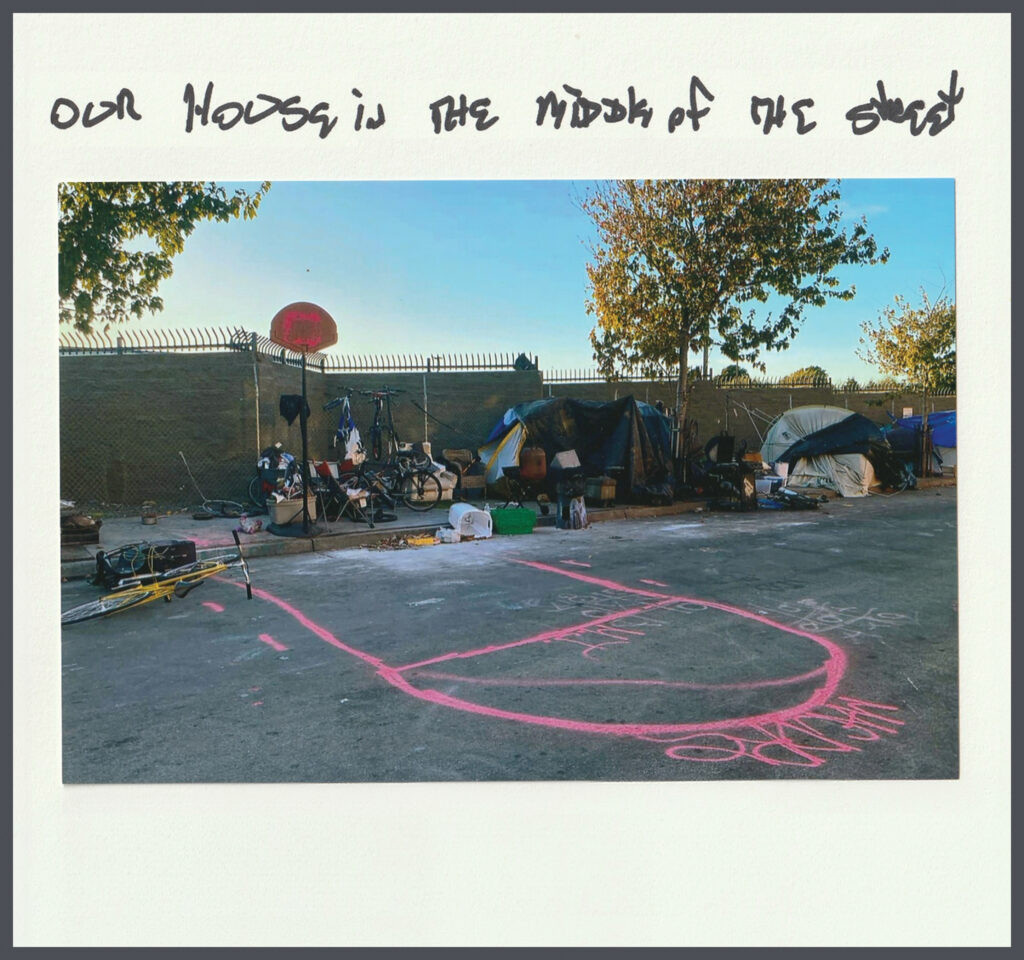 Community basketball court at Eighth Street, Berkeley, symbolizing resilience and resourcefulness.
Community basketball court at Eighth Street, Berkeley, symbolizing resilience and resourcefulness.
Established after the displacement from the Albany Bulb in 2014, this encampment at Eighth and Harrison has navigated considerable changes, particularly with the influx of new businesses into industrial West Berkeley. These new commercial neighbors have increasingly advocated for the complete removal of the encampment. Some businesses even initiated a lawsuit against the City of Berkeley in September 2024, amplifying the pressure on the city to dismantle what they see as an unwelcome presence in their burgeoning business district.
The City of Berkeley responded to this pressure on January 7th by posting an official notice of closure for Eighth and Harrison. Framing the encampment as a “health hazard and public nuisance,” the notice declared that as of February 10th, the area would be “off-limits to public lodging.” This notice further stated that “all personal property in the area will be subject to removal,” and warned that “failure to comply may result in citations and/or arrest.” Despite the looming eviction, a sense of weary resignation prevails among the residents of Eighth and Harrison. Evictions are not a new experience for them; many have faced displacement from various locations across Berkeley. While the West Berkeley encampment has been a stable point in their lives for years, there was no illusion of permanence. Clarence Galtney, a long-term resident who has since transitioned to housing, succinctly captured this sentiment before a previous sweep in November 2023, stating, “If [the city] ain’t losing sleep, why should I?” This quote encapsulates the resilience and pragmatic outlook of those facing constant uncertainty.
Over time, as larger encampments within Berkeley have been systematically closed, Eighth and Harrison has become a vital sanctuary, a refuge when options dwindle. Beyond eviction operations, the community experiences a relative absence of police interference, allowing a fragile stability to persist. Regular support arrives in the form of food and supplies from organizations like Food Not Bombs, various advocacy groups, and local church communities. Service providers find it easier to locate their clients here, offering essential medical care and assistance with housing applications. The presence of a serviced porta-potty addresses basic sanitation needs, contributing to a semblance of normalcy amidst challenging circumstances.
Yet, the most critical element of Eighth and Harrison is its people – the profound sense of community. This social fabric is paramount for survival for those experiencing homelessness in Berkeley. Residents know each other, look out for one another, and create a network of mutual support. Each individual’s path to the encampment is unique, but once part of this community, many find a reason to stay, finding solace and strength in shared experience.
This project aims to illuminate these personal narratives, offering readers a deeper understanding of the individuals who have built their lives at Eighth and Harrison. As student reporters, we have spent the last two years engaging with this community, distributing supplies, conducting interviews, taking photographs, and documenting previous eviction attempts. As February 10th approaches, we feel a responsibility to ensure that the story of this community is remembered beyond official reports, city council agendas, and fleeting news articles about the eviction’s aftermath. Our goal is to contribute to a lasting record of their community, to tell their story, not just chronicle its dissolution.
Over several months, we meticulously reviewed hours of interviews and curated a collection of photographs. Returning to Eighth and Harrison, we shared this work with the residents. We placed photos in notebooks and invited residents to add captions, notes, and personal reflections. These handwritten annotations are included alongside the photographs in the following sections. Accompanying some photographs are resident profiles, drawn from our interviews, offering intimate glimpses into their lives, their struggles, and their contributions to this unique urban community.
It’s important to acknowledge that this project is not an exhaustive account of the Eighth and Harrison community. Many have passed through over the years, some have secured housing, and some chose not to participate in this project. Regardless of individual inclusion, we dedicate these narratives to everyone who has called Eighth and Harrison “Our House In The Middle Of The Street” over the last decade.
This is a story fundamentally about community, about humanity, and about memory. The future for the residents of Eighth and Harrison after February 10th remains uncertain. However, the legacy of this place, their “house in the middle of the street,” will endure, resonating long after the physical structures are gone and the tents are cleared.
Below is a collection of photographs and handwritten notes from the residents of Eighth and Harrison, offering a personal and poignant perspective on their community. Credit for these visual and written records goes to Cole Haddock and Maria Toldi.
Residents of Eighth and Harrison: Personal Stories from Our House
Yesica: The Advocate and Journalist
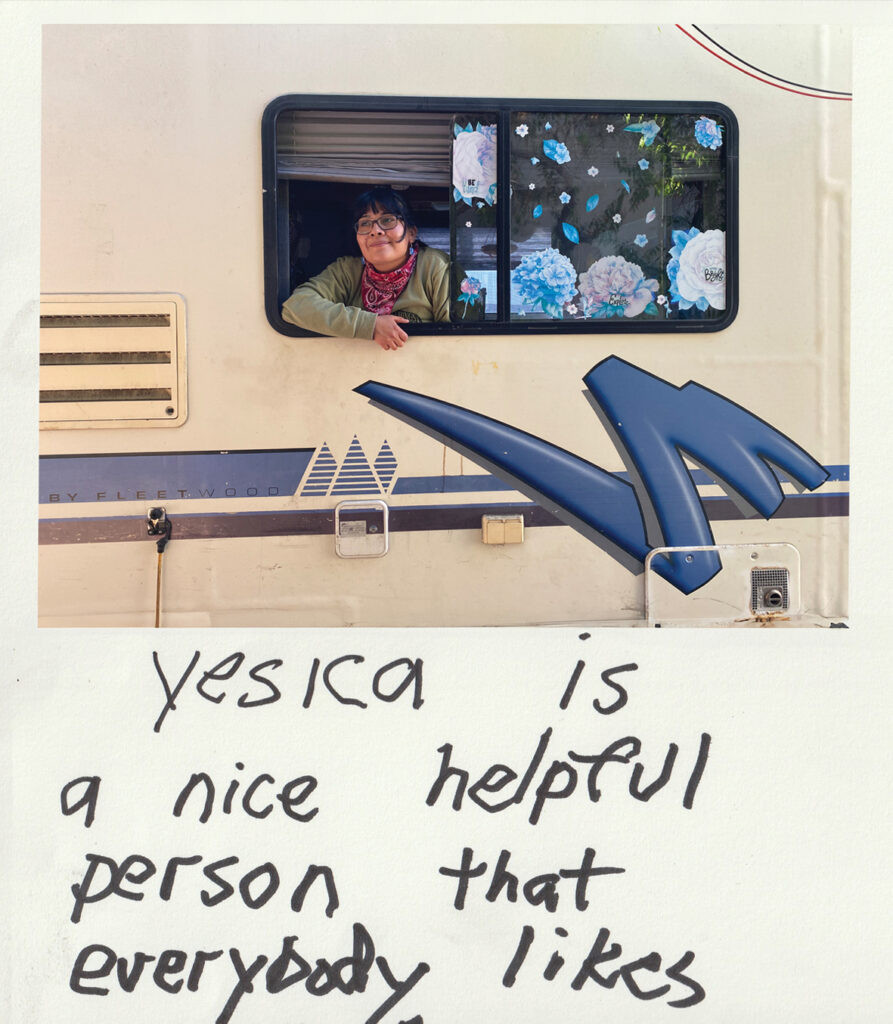 Yesica, a resident of Eighth and Harrison, Berkeley, journalist and community advocate.
Yesica, a resident of Eighth and Harrison, Berkeley, journalist and community advocate.
Yesica embodies kindness and integrity. A gifted investigative journalist and photographer, she came to Berkeley to pursue graduate studies at UC Berkeley’s Graduate School of Journalism. Financial constraints led her to live in an RV, inadvertently drawing her into the vibrant unhoused community of Berkeley.
Her RV, parked at the corner of Eighth and Harrison, is a haven filled with music, plants, and her cat, Dog. Living within this community has profoundly influenced her career, driving her commitment to uplift and represent her neighbors. Yesica is deeply engaged in her community, always ready to listen and converse with anyone who approaches. She provides practical support, offering rides to medical appointments, assisting with camp clean-ups, and advocating for residents’ rights as an organizer with the Berkeley Homeless Union. As a journalist, she is dedicated to holding public institutions accountable and amplifying the voices of her community, ensuring their stories are heard with dignity and respect.
Erin: Architect of the Hovel, a Unique Urban Dwelling
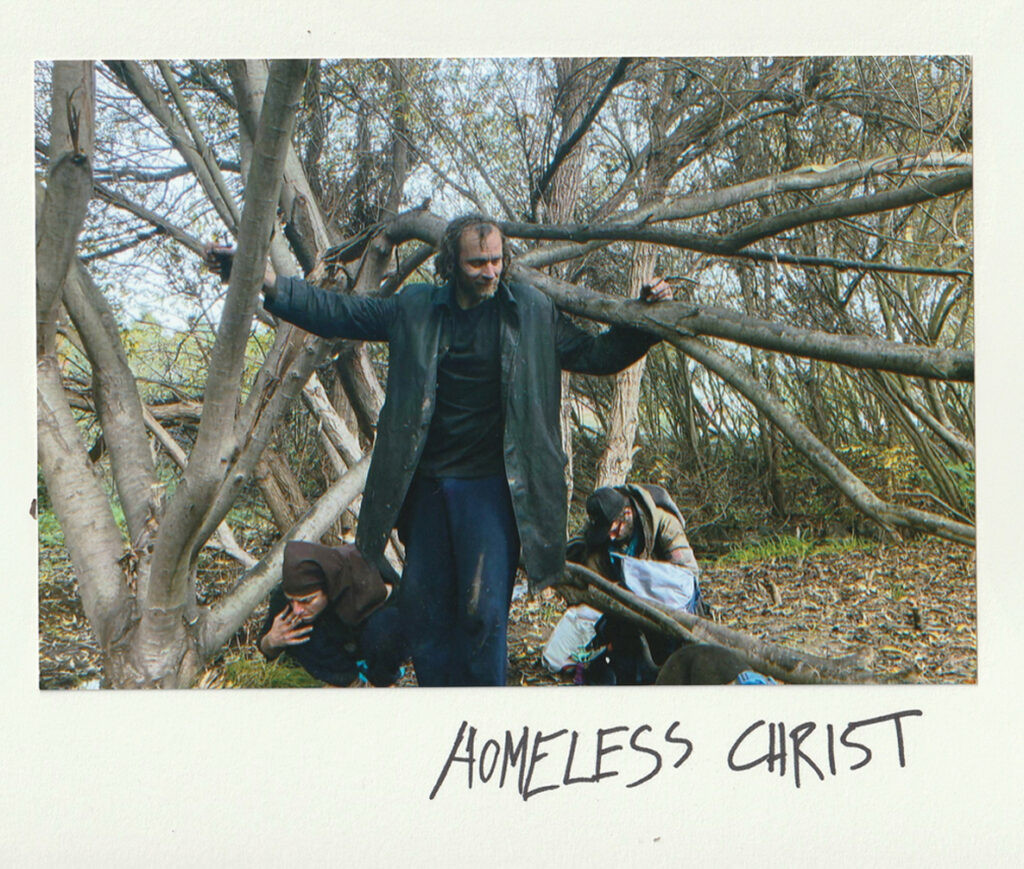 Erin, resident of the Hovel at Eighth and Harrison, Berkeley, community builder and advocate.
Erin, resident of the Hovel at Eighth and Harrison, Berkeley, community builder and advocate.
Erin often responds to the question “How are you?” with a wry, “well enough under the day.” His speech is distinctive, marked by a sharp wit and a mind steeped in literature and experience—a former Marine who learned to read before he could walk. Growing up in East Texas, the son of a Mormon veteran, Erin navigated a world of football and baseball cards while immersed in the Bible, The Lord of the Rings, and the U.S. Marine Guidebook. Feeling out of place in Texas, he sought a different home in California, though his Texan vocabulary and strong moral compass remained.
On the north side of Harrison, between Seventh and Eighth streets, Erin conceptualized and constructed “the Hovel,” his unique communal dwelling designed as a refuge for “runaways.” The Hovel sprawls across more than half a block, a structure of city fences, plywood, tarps, and blankets, intentionally created as a harassment-free zone. Erin extends an invitation to anyone, regardless of background or circumstance—veterans, single individuals, people with disabilities, those with long histories of homelessness—all are welcome, provided they contribute to maintaining the space. These are demographics often marginalized and facing prolonged waits on housing lists, enduring the stigma of chronic homelessness. The Hovel offers radical acceptance, turning no one away and ensuring no one is left to face their struggles alone.
Erin’s approach has garnered attention, even reaching the Supreme Court where Justice Sonia Sotomayor mentioned his name in the Grants Pass vs. Johnson case. He has also been interviewed by The Guardian and New York Times, and is sometimes called “Homeless Christ” by others in the unhoused community, recognizing his service and dedication.
Erin’s work challenges societal norms, making some uncomfortable. His core belief is in the fundamental right to exist, even outside conventional societal structures. He operates on the principle that everyone possesses inherent value and deserves dignity, community, and sanctuary, whether housed or unhoused. Community is central to Erin’s mission with the Hovel, a crucial element he sees as often lost when individuals accept isolated shelter options like transitional hotels with restrictive rules and no-visitor policies. “The social aspect of our existence is so key,” Erin emphasizes. “Put somebody in a box alone by themselves and they’ll die, straight up.” He understands that community, like the one at Eighth and Harrison, is not just a social benefit, but a vital necessity for survival and well-being.
Popcorn: The Modern Hobo Finding Home on Harrison Street
 Popcorn, a resident of Eighth and Harrison, Berkeley, embodying the spirit of a modern hobo.
Popcorn, a resident of Eighth and Harrison, Berkeley, embodying the spirit of a modern hobo.
Popcorn embodies the spirit of a bygone era, a modern-day hobo who, a century ago, might have been riding the rails. He lives by a code of travel, resourcefulness, and camaraderie, always ready to share if he can. Popcorn sees himself as a scavenger, a fixer, and a traveler, each with a place in the world. Behind thick glasses and beneath a somewhat untamed beard, he carries a gentle demeanor, especially when interacting with Sylvia, his energetic pitbull puppy.
Berkeley became a longer stop than initially planned in Popcorn’s journey across California, which included experiences from raising a child in San Diego to observing the vibrant scene at Venice Beach. His arrival at the Hovel was almost inevitable, and he quickly integrated into the community. Quiet and thoughtful, Popcorn finds contentment in reading and the connections he’s made at Eighth and Harrison. He explains that he stays at the Hovel because solitude, away from community, feels isolating. Recently seen reading a novel inside the Hovel, with a companion nearby, Popcorn seems to have found a temporary, yet meaningful, home with his new community.
Tom: Long-Term Resident Grappling with Change
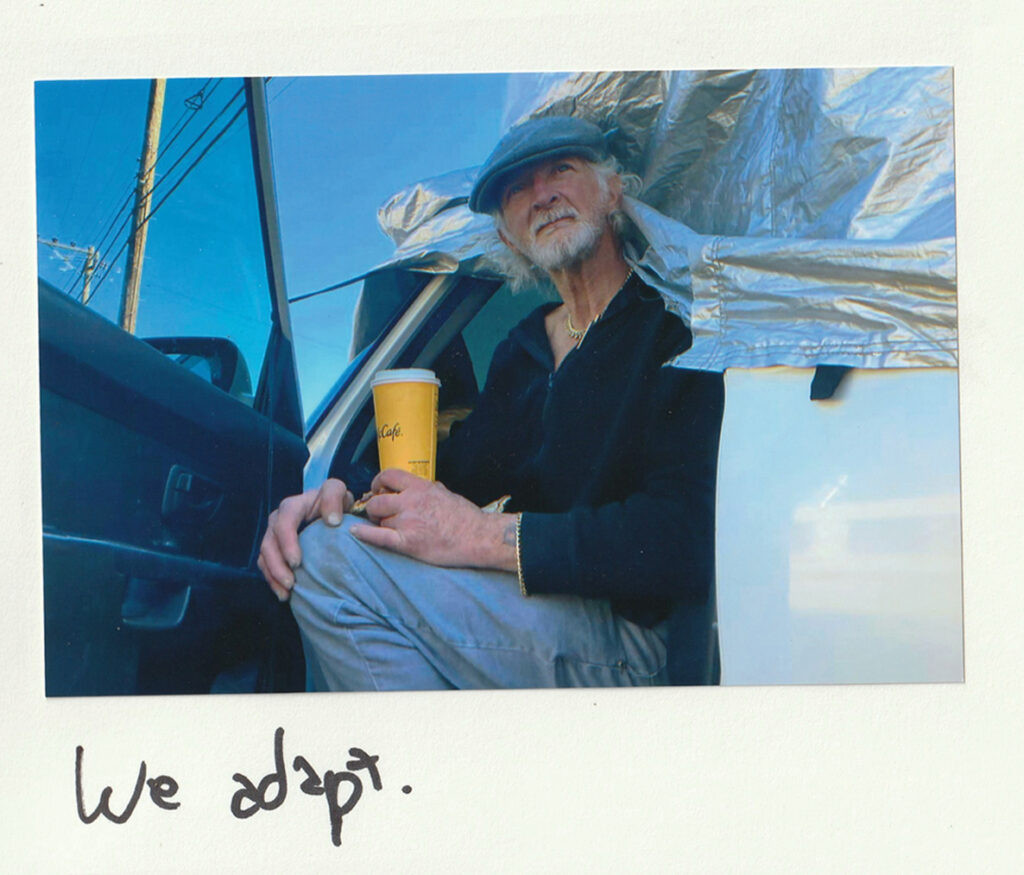 Tom, a long-term resident of Eighth and Harrison, Berkeley, reflecting on community and solitude.
Tom, a long-term resident of Eighth and Harrison, Berkeley, reflecting on community and solitude.
Tom is a man of few words, a familiar face at Eighth and Harrison, often seen but quietly observant. Originally from Kansas City, his cross-country motorcycle journey led him to California, where he has remained for many years. His passions include motorcycles and distinctive necklace chains. After 34 years living on the streets, Tom represents the long-term residents who have seen the community evolve. He usually keeps to himself on Harrison Street but frequently visits other tents, valuing the casual interactions.
In 2023, Tom secured permanent housing but found the transition unexpectedly challenging. The quiet and solitude of an apartment were jarring after decades in the vibrant, if unpredictable, environment of the streets. “Whenever I stopped by that apartment, I almost felt, like, a lonesome feeling,” Tom explained. “Out here, it’s the opposite. There’s always someone around, always someone talking. Out here, you always have people around you.” He eventually lost the apartment due to vacancy, underscoring the deep social ties formed within the encampment.
Now facing the challenges of aging and Alzheimer’s, Tom recognizes the increasing need for indoor living. He is vulnerable to exploitation, often becoming a target for theft, particularly of his bikes. The thought of declining health and the dangers of street living, especially pneumonia, weigh on him. Despite the ingrained habits of street life, Tom is considering seeking housing again, driven by the practicalities of health and safety in his later years. His story highlights the complex pull of community and the difficult adjustments faced when trying to leave street life behind.
Alice: From Survivor to Community Pillar
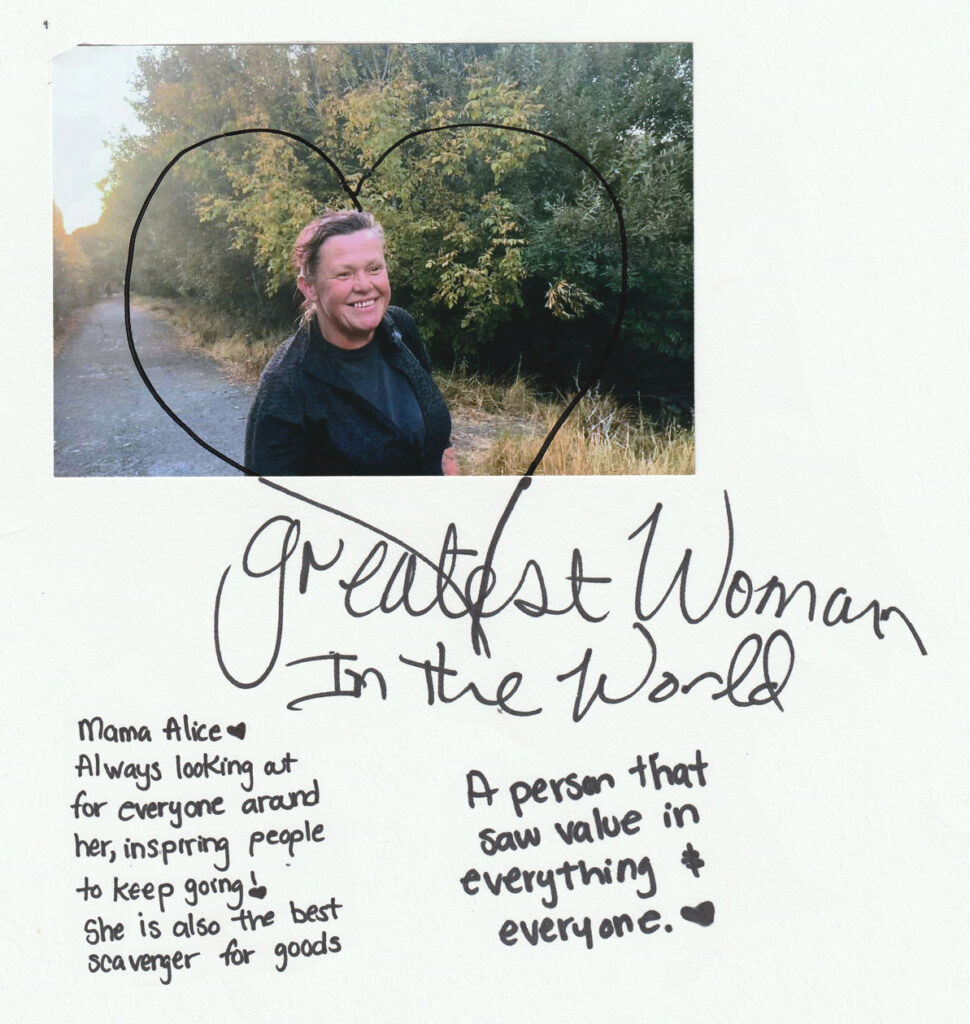 Alice, formerly a resident of Eighth and Harrison, Berkeley, now a community supporter and artist.
Alice, formerly a resident of Eighth and Harrison, Berkeley, now a community supporter and artist.
Alice exudes confidence and warmth. During her interview, she transformed the sidewalk into a welcoming space, laying down a rug and addressing the microphone with natural ease and charisma. Alice, who now lives in an apartment, remains a vital presence at Eighth and Harrison, frequently returning to support her former neighbors.
For the year Alice resided at the encampment, her spot on Eighth Street was easily recognizable, marked by a well-kept tent and a distinctive koi fish flag. Her favorite song is Peggy Lee’s “Fever,” and she dreams of opening a karaoke bar. Her pitbull, while protective, was known for her affection towards those Alice trusted. A painter with a flair for style, Alice always presented herself with care and vibrancy.
Alice came to Eighth and Harrison as a survivor of domestic abuse, finding refuge and healing within the community. She credits the encampment with saving her life, emphasizing the profound support system she found there. “We’re a great support group out here,” Alice stated. “We build each other up. Even if it isn’t exactly home, it still gives you a sense of it.” Her story underscores how the encampment functions as more than just a place to sleep; it’s a crucial network of mutual aid and emotional support.
Brenda: The Matriarch of Eighth and Harrison
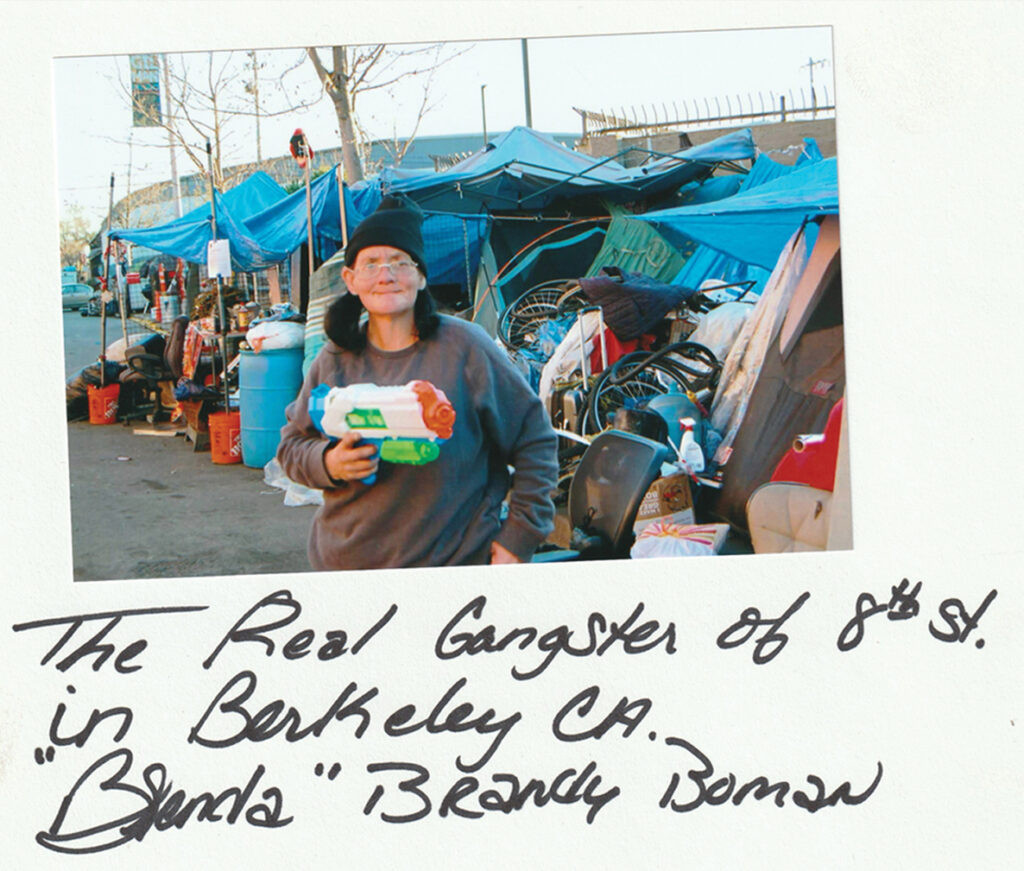 Brenda, a resident of Eighth and Harrison, Berkeley, a matriarch and community caregiver.
Brenda, a resident of Eighth and Harrison, Berkeley, a matriarch and community caregiver.
Brenda is the embodiment of a matriarch—a devoted wife, mother, grandmother, and dog-mom. She and her partner Hector, along with their dog Boo Boo, relocated to Eighth and Harrison from Richmond, but family remains central to her life. Brenda instinctively speaks in “we’s,” always considering her family as a unit. Her concerns and aspirations are collective: “We love you, we’ll miss you. We’ve been trying to get housing for ages. We’re thinking about moving towns.”
Individually, Brenda is a force of nature. Growing up on a farm in Klamath Falls, Oregon, she learned resilience and self-reliance early on. She worked tirelessly for years, often holding down jobs at both Great America and Levi’s Stadium. Despite her warm smile, she commands respect and treats everyone with dignity, expecting the same in return. “We’re all brothers and sisters out here,” she emphasizes, “whether we’re pushing a shopping cart, sleeping in a tent, or have nowhere to go. Respect others.”
Brenda’s dream is a spacious five-bedroom home for her entire family, complete with a jacuzzi, where she can care for everyone. “I’m tired of being out here, dealing with all this shit. I want to be in a house. I want to be home, where I can have my friends and my family, my daughter and my grandbaby.” Her vision of “home” is deeply rooted in family and care, reflecting her role as the heart of her community at Eighth and Harrison.
Dulley: Navigating the System, Finding Rhythm in the Streets
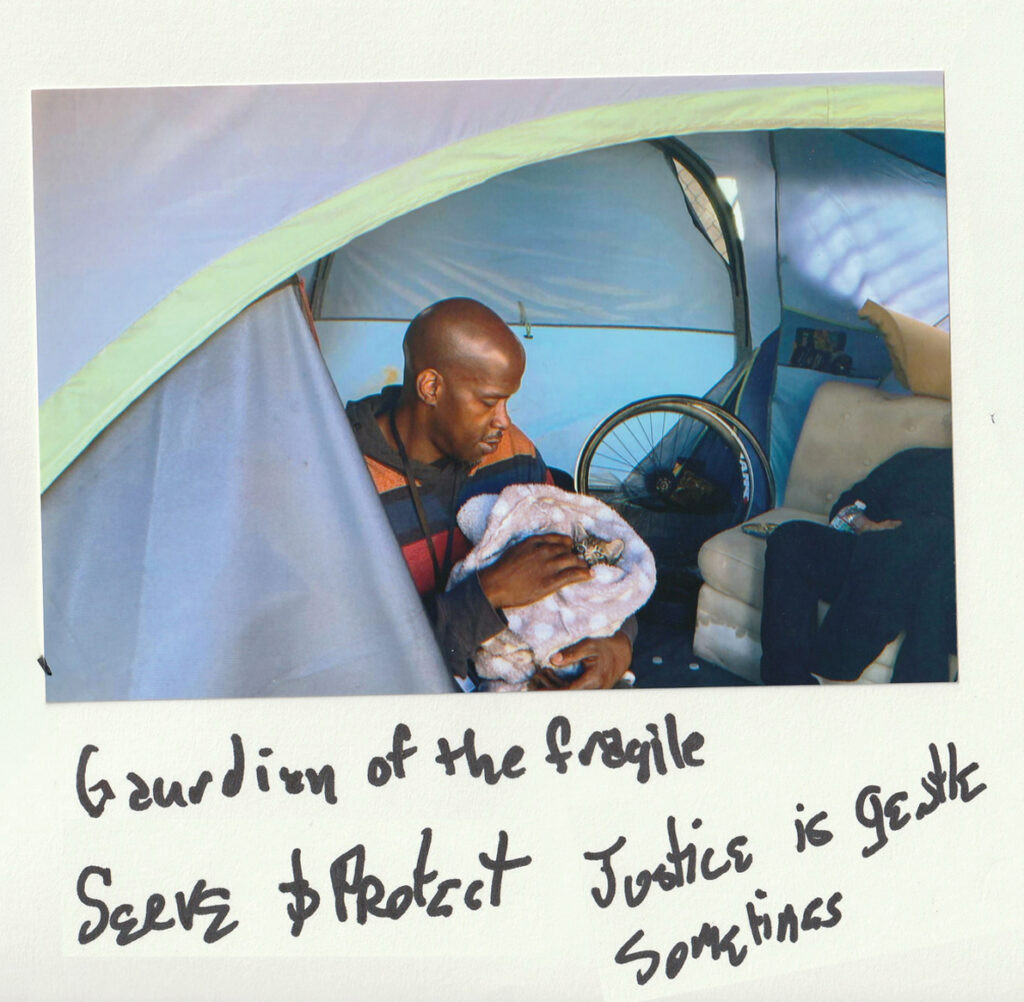 Dulley, a resident of Eighth and Harrison, Berkeley, musician and advocate for housing.
Dulley, a resident of Eighth and Harrison, Berkeley, musician and advocate for housing.
Dulley is a striking presence at Eighth and Harrison, often seen with his music speaker or practicing with fire sticks, filling the street with sound and motion. When first interviewed, he was found inside his tent, gently playing with a kitten he was minding for a friend, showcasing his caring nature amidst a tough environment.
Growing up in Richmond, Dulley found early grounding in sports, playing football and baseball. However, disciplinary issues led to his removal from teams, followed by a period in juvenile hall. Since then, his life has been marked by cycles of incarceration, parole, and homelessness. He has been living on the streets since 2003, the year he was released from San Quentin after serving eight years. An extended parole period, due to bureaucratic issues, further complicated his reentry. Dulley feels deeply let down by a system that he believes has repeatedly failed him.
“I’ve been homeless out here since 2003. Trying to get housing, trying to get something going on for myself,” Dulley explains. “I’ve been severely looked over and passed upon. I thought I was practicing patience, but now…it’s been double-digit years.” He continues to fight for housing, navigating a bureaucratic maze that he experiences as consistently frustrating and ineffective. Temporary shelters and programs have offered only fleeting relief, never providing a lasting solution. “The whole process frustrates me to the point where my anxiety kicks in,” he admits. “It’s a big waste of time.” Despite these systemic challenges, Dulley persists, seeking stability and a place to call home.
RJ: Resilience on the Corner
 RJ, a long-term resident of Eighth and Harrison, Berkeley, facing health challenges with community support.
RJ, a long-term resident of Eighth and Harrison, Berkeley, facing health challenges with community support.
RJ has been a fixture at the corner of Eighth and Harrison for years. Originally from New Orleans, his childhood was spent largely in foster care before he moved to California seeking work. He faces significant health challenges, exacerbated after being hit by a car in 2023, and lives with the loss of an eye and a finger. Mobility is difficult for RJ, but he makes efforts to use his wheelchair for errands when possible, demonstrating his determination to maintain independence.
RJ relies on the support of outreach workers and fellow residents for necessities like food and medicine. When asked about RJ’s housing situation, an outreach worker explained that his need for specialized nursing care and assistance exceeds available resources, leaving him without suitable accommodation options. “The pavement was hard on his back,” RJ often remarks, and he frequently expresses hope for an RV or an apartment, constantly seeking a way to improve his living situation.
Cars passing by RJ’s tent are a constant presence, sometimes speeding dangerously close. During one interview, a car slowed down to shout, “Hey! You could get hit!” before driving off, highlighting the precariousness of his street-side existence. RJ responded with a poignant observation: “They don’t realize how much a neighbor makes a difference. I’m your neighbor and you’re mine.” This statement encapsulates the core of community at Eighth and Harrison – mutual recognition and support in the face of daily challenges.
Sharif: The Warrior-Priest and Scholar
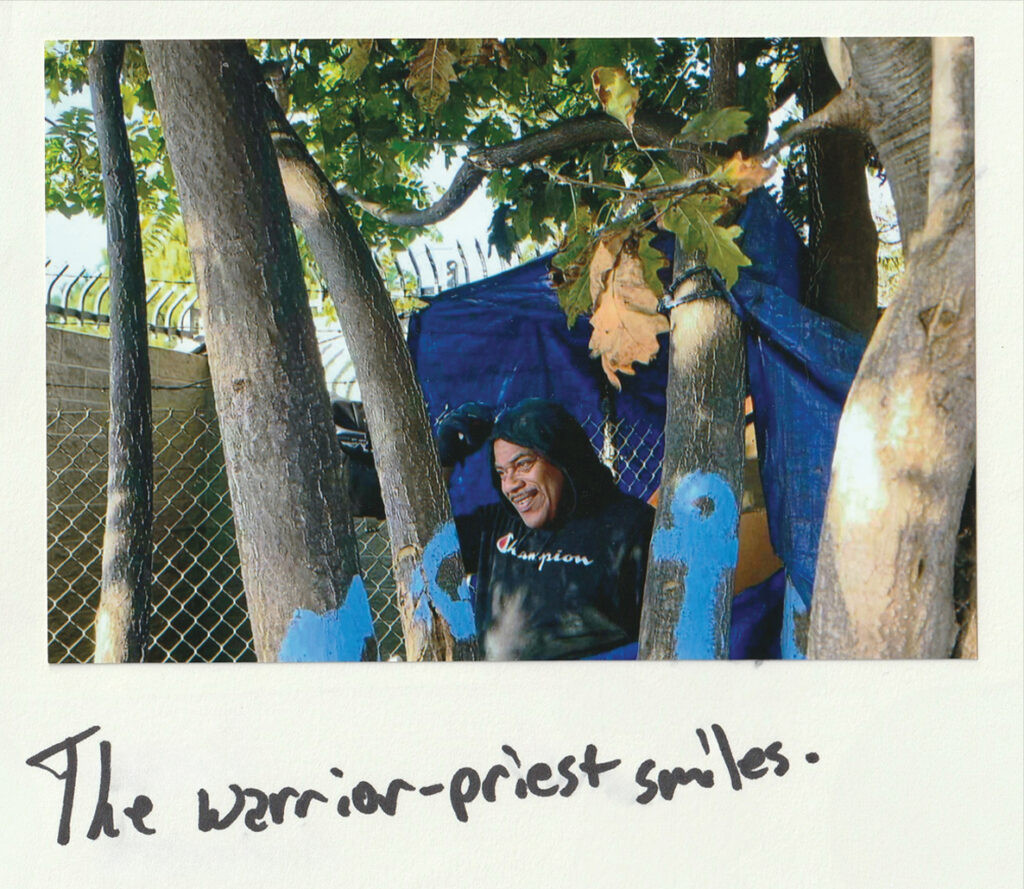 Sharif, a lifelong Berkeley resident and veteran at Eighth and Harrison, a scholar and community voice.
Sharif, a lifelong Berkeley resident and veteran at Eighth and Harrison, a scholar and community voice.
Sharif, a Berkeley native, is deeply rooted in the area’s history, an “old head” with a profound connection to his surroundings. A Marine Corps veteran and a scholar of Octavia Butler, his intellect and reflective nature are immediately apparent in conversation. He vividly recalls a time when thick bay fog enveloped the East Bay and when the redwood trees in People’s Park were revered. Sharif speaks with eloquence, framing his experiences and observations of the world in language that is both poetic and prophetic—a true “warrior-priest” of Eighth and Harrison, offering wisdom and perspective to his community.
Elf: Poet and Animal Advocate
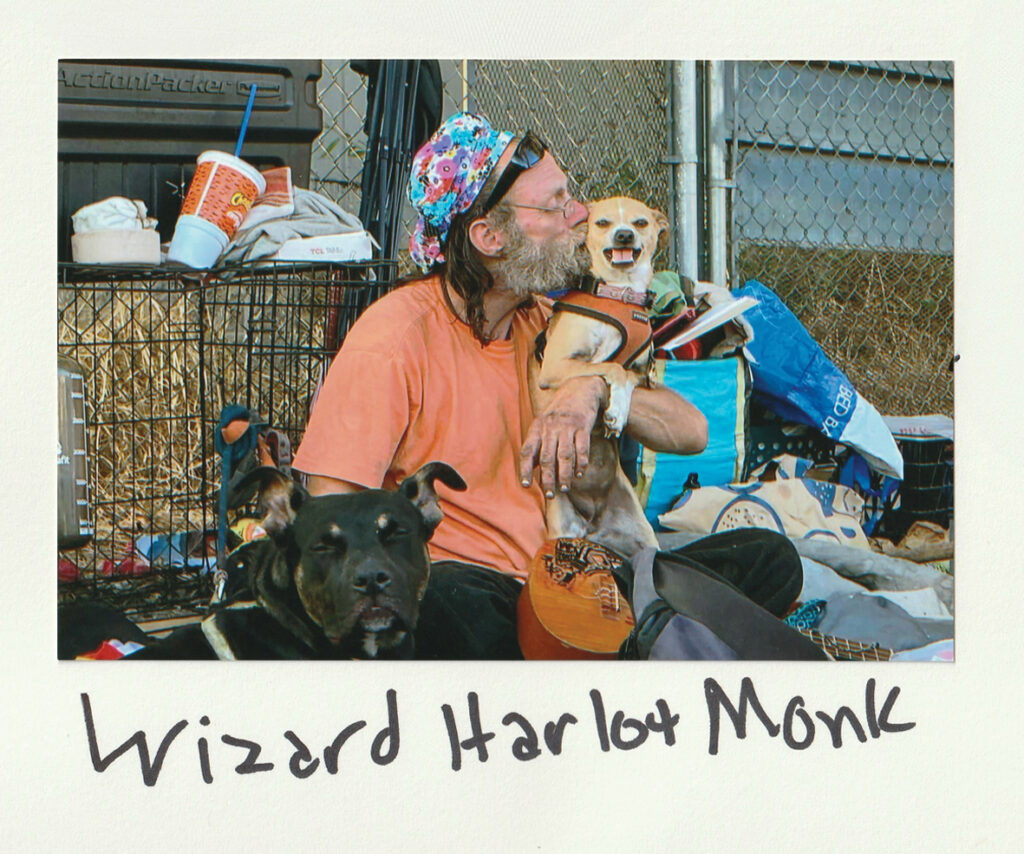 Elf, a resident of Eighth and Harrison, Berkeley, poet, filmmaker, and animal lover.
Elf, a resident of Eighth and Harrison, Berkeley, poet, filmmaker, and animal lover.
Elf resides at Eighth and Harrison with his dog Bella, whose gentle nature belies her appearance. An advocate for animals, Elf previously lived in Oregon, working as a documentary filmmaker and printmaker. He is also a published poet. His poem from Street Spirit in 2018, reflects his contemplative view of daily life:
Each day / Begins / The same—we / Open our eyes / and / begin / to / see / anew.
This poem captures a sense of renewal and resilience, mirroring the daily experiences of those in the Eighth and Harrison community.
Mike: The Scoundrel with a Golden Heart
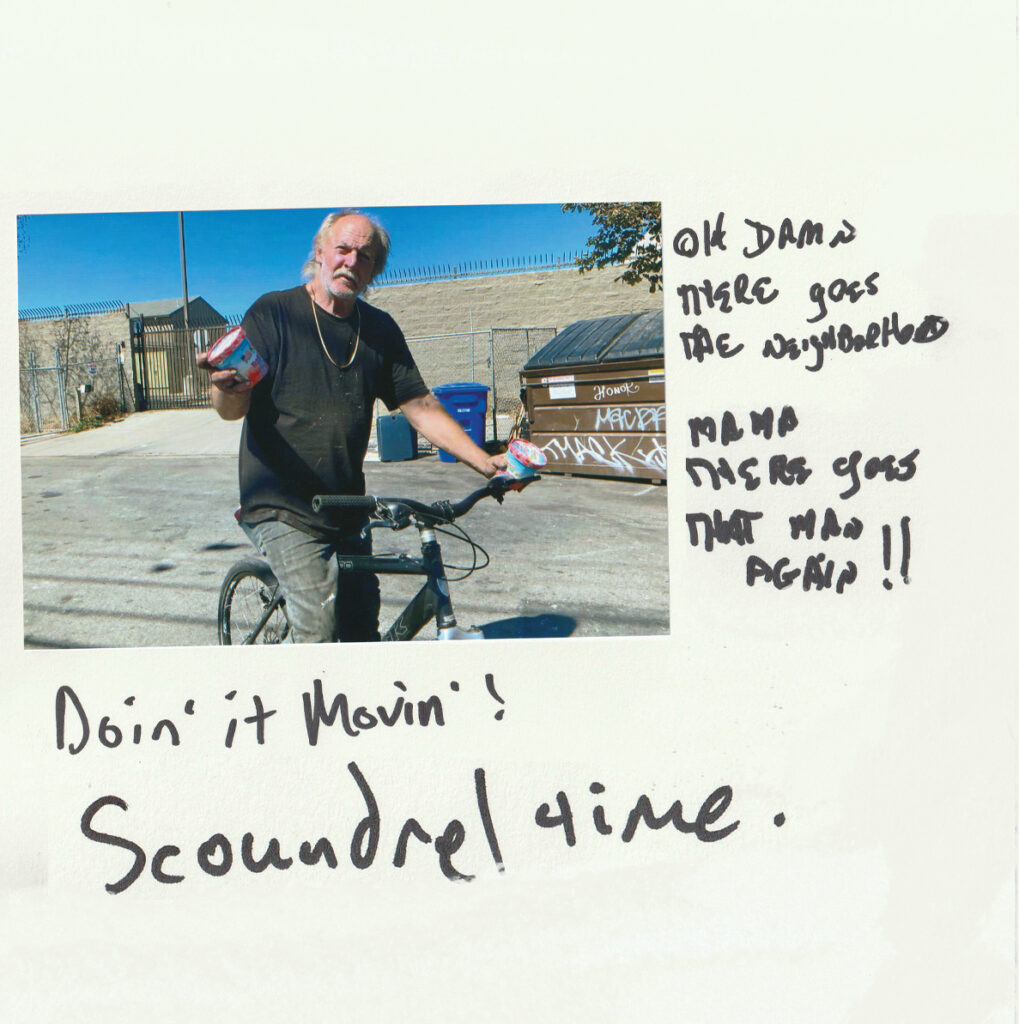 Mike, a long-term resident of Eighth and Harrison, Berkeley, known for his charisma and community spirit.
Mike, a long-term resident of Eighth and Harrison, Berkeley, known for his charisma and community spirit.
Mike is a charismatic figure, a long-term fixture of the Eighth and Harrison community, known for his playful nature and loyalty. His inseparable companion is Boy, a large black pitbull with distinctive white markings. The pair are a familiar sight throughout Berkeley, often seen sharing popsicles and enjoying each other’s company. Mike, if you’re lucky, might treat you to an impromptu rap performance, showcasing his lyrical talents and vibrant personality. Despite his “scoundrel” persona, Mike is deeply embedded in the community fabric of Eighth and Harrison, contributing to its unique and resilient spirit.
Cole Haddock and Maria Toldi, the contributing writers and filmmakers behind this project, are students at UC Berkeley and contributors to San Quentin News. Through their dedicated and patient journalism, they aim to capture and celebrate the beauty of community resilience, as exemplified by the residents of Eighth and Harrison, their “house in the middle of the street.”

